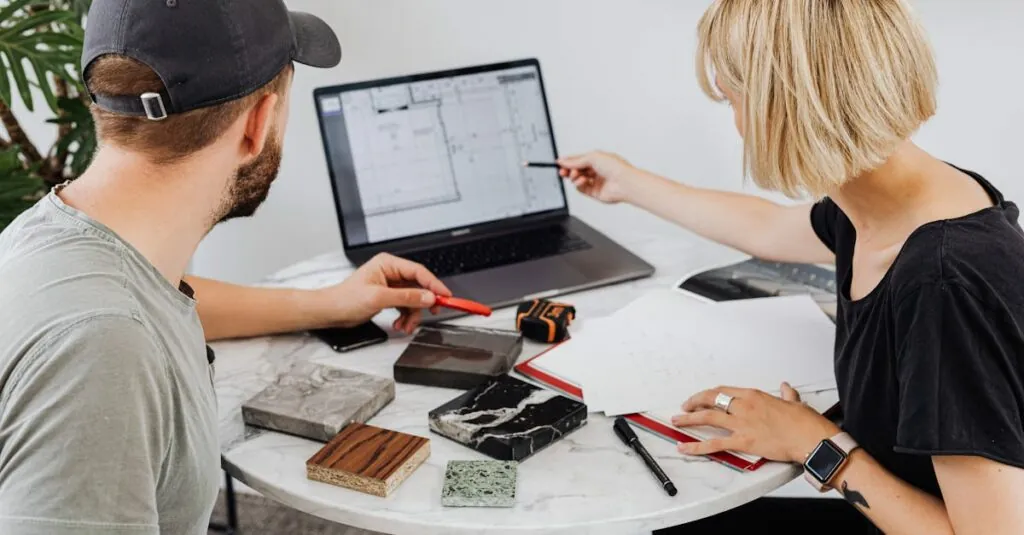In the fast-paced world of design, having the right tools can make or break a project. Imagine trying to create a stunning graphic on a laptop that struggles to keep up with your creativity. It’s like trying to paint a masterpiece with a broken brush—frustrating and downright tragic. Designers need laptops that can handle the heavy lifting, from rendering high-res images to running complex design software without breaking a sweat.
Table of Contents
ToggleOverview of Laptops for Designers
Designers require laptops that deliver power and performance for demanding tasks. Essential features include high-resolution displays that accurately reproduce colors, enabling precise visual work. Memory capacity also plays a critical role; 16GB RAM is often the standard for running multiple design applications simultaneously without lag.
Processing power matters significantly. Multi-core processors, such as Intel i7 or AMD Ryzen 7, enhance speed when rendering images or processing video. A dedicated graphics card becomes vital for graphic-heavy applications, allowing for seamless 3D modeling and rendering. Several laptops come equipped with NVIDIA GeForce or AMD Radeon GPUs, offering designers the necessary performance boost.
Battery life impacts usability, especially during client meetings or when working remotely. A minimum of 8 hours of battery life is desirable to ensure that designers can work efficiently without frequent charging interruptions. Lightweight designs also enhance portability, which often suits professionals who travel or work on-site.
Storage options matter too. Solid-state drives (SSDs) provide faster loading times and quicker access to files compared to traditional hard drives. Designers benefit from SSDs due to speed advantages when working with large project files. A capacity of 512GB is ideal, but options up to 2TB exist for those needing extra space for extensive portfolios.
Connectivity features also play a part in a designer’s workflow. Multiple USB ports, HDMI outputs, and SD card slots improve versatility for connecting external devices and accessories. Wireless capabilities, including Wi-Fi 6, offer improved internet speeds and reliability, essential for downloading large files or utilizing cloud-based resources.
Key Features to Consider
Selecting the right laptop hinges on key features that enhance design work. Designers need to focus on performance capabilities and display quality to ensure efficiency and accuracy in their projects.
Performance and Processing Power
Multitasking requires at least 16GB RAM for smooth performance while running multiple applications. Powerful processors, such as Intel i7 or AMD Ryzen 7, deliver the speed necessary for complex design tasks. Efficient performance reduces frustration during high-demand projects. Upgradeable RAM options allow for future enhancements as software requirements evolve. Ultimately, a laptop’s processing capabilities significantly impact overall workflow.
Graphics Card Importance
Dedicated graphics cards, like NVIDIA GeForce or AMD Radeon, are vital for graphic-intensive applications. Enhanced rendering speeds make 3D modeling and design software operate fluidly. Professionals benefit from using laptops equipped with these graphics cards, ensuring high-quality visuals. The right GPU supports real-time rendering, allowing designers to view changes instantly. Additionally, adequate video memory is essential for handling demanding projects without lag.
Display Quality and Color Accuracy
High-resolution displays are necessary for precise color reproduction in design work. IPS panels offer better color accuracy and wider viewing angles than standard displays. Minimum resolution of 1920×1080 ensures sharp images and clear details in designs. Designers working with color-sensitive projects must prioritize displays that cover 100% of the sRGB color gamut. Touchscreen capability can also enhance interactivity, further benefiting design workflows.
Recommended Laptops for Designers
Laptops for designers should combine power, efficiency, and portability. Here are some top options across different categories.
High-End Options
For professionals demanding peak performance, the Apple MacBook Pro 16-inch stands out. This laptop features an M1 Max chip, which delivers exceptional speed for complex design software. Dell XPS 15 also meets high standards, showcasing an Intel i7 processor and NVIDIA GeForce GTX 1650 Ti graphics card. Both options include vibrant 4K displays that ensure accurate color representation, making them ideal for graphic-intensive tasks. With a minimum of 16GB RAM and large SSD options, these laptops facilitate seamless multitasking.
Budget-Friendly Choices
Budget-conscious designers can turn to the ASUS VivoBook 15 as a reliable option. It provides solid performance with an AMD Ryzen 5 processor and 8GB RAM, proving effective for everyday design tasks. Another great choice is the Acer Aspire 5, offering a responsive Full HD display and a dedicated NVIDIA GeForce MX350 graphics card. Both laptops maintain affordability while ensuring decent storage, with at least 512GB SSD available in their configurations. These choices balance cost and capability, making them excellent for entry-level designers.
Ultrabooks for Portability
Portability remains essential for many designers, and the Lenovo ThinkPad X1 Carbon rises to the occasion. It combines a lightweight design with a powerful Intel i7 processor and 16GB RAM, providing excellent performance on the go. Another notable ultrabook is the HP Spectre x360, featuring a 2-in-1 design and a vivid touchscreen display. Both ultrabooks ensure extended battery life, typically exceeding 10 hours, making them convenient for remote work and client meetings. Their efficient designs and robust specifications cater to the needs of creative professionals.
Tips for Choosing the Right Laptop
Assess performance requirements based on the design tasks expected. A minimum of 16GB RAM ensures smooth multitasking, while powerful processors like Intel i7 or AMD Ryzen 7 enhance overall speed. Check for dedicated graphics cards like NVIDIA GeForce or AMD Radeon, as they are crucial for graphic-intensive applications.
Evaluate display quality carefully. High-resolution screens with a minimum of 1920×1080 resolution provide accurate color reproduction. Target laptops that cover 100% of the sRGB color gamut for color-sensitive projects. Look for IPS panel technology, guaranteeing better viewing angles and color fidelity.
Consider battery life for extended working hours. Choosing laptops with at least 8 hours of battery life prevents interruptions during client meetings or in remote settings. Lightweight designs also aid portability, making it easier to carry devices during travels.
Prioritize storage capabilities. Opt for solid-state drives (SSDs) for faster loading times. Storage capacities ranging from 512GB to 2TB cater to extensive design portfolios, ensuring ample space for large files and applications.
Examine connectivity features. Multiple USB ports and Wi-Fi 6 increase workflow efficiency, facilitating the use of external devices and cloud resources. A diverse range of connectivity options enhances overall usability for designers. Choose wisely to ensure the laptop meets specific design needs effectively.
Conclusion
Choosing the right laptop is crucial for any designer looking to enhance their creative workflow. With the right specifications and features, designers can tackle complex projects with ease and efficiency. Prioritizing performance, display quality, and portability ensures that they have the tools needed to bring their visions to life.
Investing in a capable laptop not only boosts productivity but also enriches the overall design experience. Whether opting for a high-end model or a budget-friendly option, having the right device can make all the difference in achieving outstanding results.





